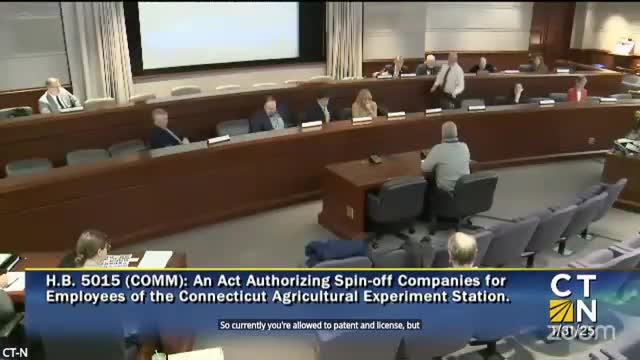Connecticut Ag Station scientist develops new pest control method to combat invasive insects
January 31, 2025 | 2025 Legislature CT, Connecticut
This article was created by AI summarizing key points discussed. AI makes mistakes, so for full details and context, please refer to the video of the full meeting. Please report any errors so we can fix them. Report an error »

The Environment Committee of Connecticut convened on January 31, 2025, to discuss critical issues surrounding environmental research and talent retention at the University of Connecticut's Agricultural Experiment Station. The meeting highlighted the importance of maintaining skilled researchers in the state to address pressing environmental challenges.
The session began with a discussion led by Rev. Dillon, who expressed concerns about the potential loss of talent from the Agricultural Experiment Station, a vital asset for the region. Dr. Hani Dweck, a recent hire, was cited as a key example of the type of researcher Connecticut needs to retain. Dr. Dweck has made significant strides in understanding the behavior of the spotted lanternfly, an invasive species threatening local ecosystems. His research could lead to the development of effective pest control products, but he faces limitations in advancing his work due to procedural constraints.
Dr. Dweck's situation underscores a broader issue: the need for Connecticut to provide adequate support and resources for researchers to innovate and commercialize their findings. The committee discussed the existing memorandum of understanding with Yukon Tech Commercialization, which facilitates licensing and patenting processes, but noted that additional support is necessary for researchers to fully realize their potential.
Representative Gresco contributed to the conversation by sharing his own experiences in nanotechnology and agriculture, emphasizing the importance of fostering an environment where new PhD scientists can thrive. He pointed out that while he is not considering leaving, many younger researchers might seek opportunities elsewhere if their needs are not met.
The meeting concluded with a call for clarity on the existing patent protocols in Connecticut and a discussion on why certain support mechanisms were not previously available to the Agricultural Experiment Station. The committee recognized the urgency of addressing these issues to ensure the future viability of environmental research in the state.
Overall, the meeting highlighted the critical intersection of environmental science, innovation, and workforce retention, with a clear message that Connecticut must enhance its support for researchers to prevent talent loss and foster economic growth through scientific advancements.
The session began with a discussion led by Rev. Dillon, who expressed concerns about the potential loss of talent from the Agricultural Experiment Station, a vital asset for the region. Dr. Hani Dweck, a recent hire, was cited as a key example of the type of researcher Connecticut needs to retain. Dr. Dweck has made significant strides in understanding the behavior of the spotted lanternfly, an invasive species threatening local ecosystems. His research could lead to the development of effective pest control products, but he faces limitations in advancing his work due to procedural constraints.
Dr. Dweck's situation underscores a broader issue: the need for Connecticut to provide adequate support and resources for researchers to innovate and commercialize their findings. The committee discussed the existing memorandum of understanding with Yukon Tech Commercialization, which facilitates licensing and patenting processes, but noted that additional support is necessary for researchers to fully realize their potential.
Representative Gresco contributed to the conversation by sharing his own experiences in nanotechnology and agriculture, emphasizing the importance of fostering an environment where new PhD scientists can thrive. He pointed out that while he is not considering leaving, many younger researchers might seek opportunities elsewhere if their needs are not met.
The meeting concluded with a call for clarity on the existing patent protocols in Connecticut and a discussion on why certain support mechanisms were not previously available to the Agricultural Experiment Station. The committee recognized the urgency of addressing these issues to ensure the future viability of environmental research in the state.
Overall, the meeting highlighted the critical intersection of environmental science, innovation, and workforce retention, with a clear message that Connecticut must enhance its support for researchers to prevent talent loss and foster economic growth through scientific advancements.
View full meeting
This article is based on a recent meeting—watch the full video and explore the complete transcript for deeper insights into the discussion.
View full meeting
